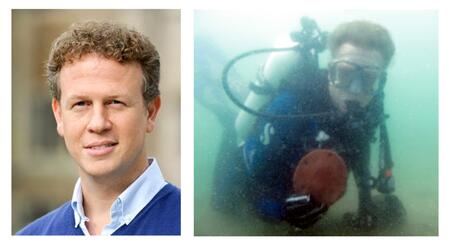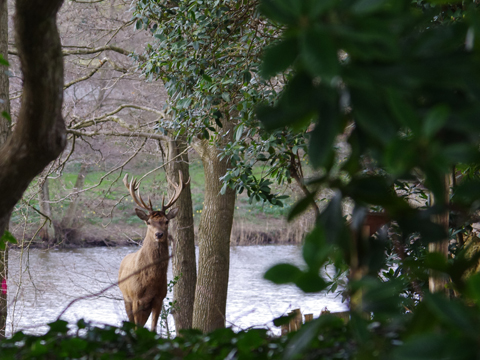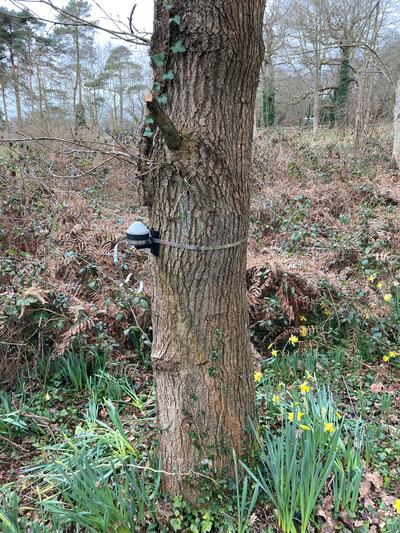Dr. Simon Coppard joined the BISC in January 2020 as a lecturer in Biology, and by the following Summer, he had been appointed our full-time Science Co-ordinator. He inherited a Science program at the Castle bursting with potential, including the brand-new BISC Science and Innovation Laboratories. Of course, a global pandemic quickly sent all his students home. With in-person learning set to return in September this year, we thought we would ask him to introduce himself to our alumni and outline some of the exciting plans he has for Science programming at the BISC.
Dr. Coppard, your faculty profile describes you as a ‘multidisciplinary evolutionary Biologist.’ Would you mind telling us a little about your background, please and how you came to join the faculty at the BISC?
 I am originally from Mayfield in East Sussex, and my family has lived in the area for hundreds of years. We decided to move back to the UK from upstate New York, where I was teaching at Hamilton College, due to my wife’s work and a desire to get our son into the UK school system. I started at the BISC in January 2020 and could instantly see the potential that the site, facilities and location could offer, particularly to science students.
I am originally from Mayfield in East Sussex, and my family has lived in the area for hundreds of years. We decided to move back to the UK from upstate New York, where I was teaching at Hamilton College, due to my wife’s work and a desire to get our son into the UK school system. I started at the BISC in January 2020 and could instantly see the potential that the site, facilities and location could offer, particularly to science students.
My PhD training was in marine ecology, morphology and invertebrate systematics, which led me to positions at the Natural History Museum, London and several research fellowships at the Smithsonian Tropical Research Institute (STRI) in Panama. At STRI, I worked on producing molecular phylogenies of sand dollars to look at speciation before and after the closure of the Isthmus of Panama. Why sand dollars? Well, ecologically, they are important as they function as ecosystem engineers (species that modify their environment and create and maintain habitats), but they also have an excellent fossil record which allows accurate tracing of morphological, ecological and molecular divergence through time. This use of a combination of paleontological, ecological, morphological and genetic data allows me to apply a holistic approach to my research.
More recently, I have been working on the expression of genes that control lunar spawning; sea urchin phylogenomics; how venom has evolved in sea urchin species that live in different habitats to defend against predators and parasites, and how sea urchin gut microbiomes vary between species and locality. I bring this research into the classroom to make connections between what we are discussing as part of the Biology course and real world applications. These projects also open up opportunities for student research. This summer, I am working with Life Sciences major Erika Spagnuolo on my sea urchin venomics project.
As a systematist, I value the description of new species and taxonomic expertise. To this end, I have described a number of new species and genera, including the first species to be discovered on eBay: BBC - Outriders: An Exquisite New Species found on Ebay.
How did you respond to the challenge of virtual learning during the lockdown, and do you have a favourite virtual experiential learning opportunity (VELO) you can describe for us?
Teaching online has been challenging, particularly first-year Biology, which is very information-heavy. My teaching style is discussion-based, so I decided to make all the classes this term synchronous to encourage student interaction, both with me and each other. Essentially, I tried to give the class a similar feel to as if it was in-person, so that connections could be made. Judging from student feedback, this worked really well, although many weren’t all thrilled at the allotted class time due to the time differences between them (it was 9:00 a.m. for students in Ontario, 7:00 a.m. for students in Alberta, but 9:00 p.m. for students in China).
I believe in a skills-based approach to labs, so this term, I gave the students data but then taught them how to use open source tools to analyze the data. For example, I ran a lab/tutorial that posed the question, ‘What fish are you eating?’
I went through how they would extract the DNA from fish samples, how to run a polymerase chain reaction (PCR) test and understand DNA sequencing, but then gave them the DNA data from previous years that contained several species that had been mis-sold (when filleted, many fish species look identical after all). Students then used molecular phylogenetic tools to align DNA sequences, analyze relationships between species, and use the Nucleotide Basic Local Alignment Search Tool (NCBI BLAST) to determine if their species had been correctly identified and sold. We then discussed the implications of mis-selling fish in regard to biosecurity, fraud (where this may have occurred), protected species (CITES) and implications for human health.
This term’s VELOs focused on rewilding a habitat on the Herstmonceux Castle Estate. Students were introduced to the Estate and its habitats by Estate Manager, Guy Lucas. This was bittersweet for many students, as they finally got to see a lot more of the beautiful surroundings but further realized what they had unfortunately missed out on experiencing this year. As a class, we discussed rewilding and then in groups, students were asked to propose a specific habitat to rewild.
This included the introduction of rare or endangered species or the use of proxy species for those now extinct to provide the ecological services needed. They developed a realistic time frame with milestones for species introductions, predicted outcomes and legacy on the Estate. Students then presented their proposals at the end-of-term student conference. xx As I strongly believe in an interdisciplinary approach, I asked Dr. Tim Huzar to start the session with a talk on the philosophy of sustainability, and the students then gave excellent presentations that reflected the hard work they had put into this project and the year.
Students at the BISC get to live and work in rather unique surroundings. Are there any projects you have in mind that would leverage the access they have to the woodland, meadows and marshland right on their doorsteps?
 Yes, I am currently working with Estate Manager Guy Lucas to develop rewilding of specific habitats on the Estate that will increase biodiversity, protect both habitats and species, and in time hopefully result in the development of suitable habitats that will encourage the return of rare species. This forms part of our wider sustainable development goals, particularly addressing United Nations SDGs 13 to 15, climate action, life underwater, and life on land. We are also currently looking at installing a boardwalk through the fenlands on the Estate that contains rare plant communities (e.g. Cornish Moneywort, Milk Parsley, Water Violet) and is home to the endangered Fen Raft Spider. The hope is that this boardwalk (subject to appropriate environmental surveys) will provide protected guided access to both students and the general public, with interpretive signage that will highlight the species present and their importance to the ecosystem.
Yes, I am currently working with Estate Manager Guy Lucas to develop rewilding of specific habitats on the Estate that will increase biodiversity, protect both habitats and species, and in time hopefully result in the development of suitable habitats that will encourage the return of rare species. This forms part of our wider sustainable development goals, particularly addressing United Nations SDGs 13 to 15, climate action, life underwater, and life on land. We are also currently looking at installing a boardwalk through the fenlands on the Estate that contains rare plant communities (e.g. Cornish Moneywort, Milk Parsley, Water Violet) and is home to the endangered Fen Raft Spider. The hope is that this boardwalk (subject to appropriate environmental surveys) will provide protected guided access to both students and the general public, with interpretive signage that will highlight the species present and their importance to the ecosystem.
The boardwalk will extend the current trail system and initiate a program of educational and interpretive signage around the Estate. The aim of these projects is to link the classroom with the Estate and develop an ethos of environmental stewardship among the students during their time with us, which they will carry with them in their lives.
Do you have plans for any additional Science courses at the BISC?
I am in the process of developing new upper-year courses in Marine Biology and Science Communication. The Marine Biology course will be largely fieldwork-based with a strong emphasis on the techniques used to study biodiversity and the evolutionary and ecological processes that regulate it. Our close proximity to the coast and the range of habitats available to us, for example, sandy shore, rocky shore and estuarine habitats, make the BISC an ideal location for this course. This class will take advantage of the new Science Innovation Labs and teach the students morphological, ecological and genetic techniques to study species diversity and abundance and the appropriate statistical analyses to measure this.
The Science Communication course will have strong ties with both our rewilding projects and the Environments of Change project, with a strong emphasis on climate change both past, present and future. Students will use the habitats on the Estate and Pevensey Levels to discuss historical effects, including human population size, land use and farming in the region, and changes we are now seeing in terms of fauna and flora distribution. They will look at local changes in climate such as winter flooding, hot dry summers and variation in sea levels and how action now can help mitigate these effects. They will also discuss the future effects under various models and scenarios. The aim is to collaborate with the Observatory Science Centre (OSC) and develop a course that uses their expertise to develop a curriculum that results in students developing displays and content that they then deliver to the public, both on the Estate and at the OSC. As part of this course, I envisage students taking their work out into the wider community, including schools and community centres, highlighting the work being done at the BISC and therefore making it more accessible.
 You mentioned the Environments of Change project with Dr. Steven Bednarski. Can you tell us what the plan is once lockdown is lifted and students can get back out in the field again?
You mentioned the Environments of Change project with Dr. Steven Bednarski. Can you tell us what the plan is once lockdown is lifted and students can get back out in the field again?
It will be great to have students back in person! This term, I have been working with two Master’s students (Erin Kurian and Jacqueline Gergal, from our long-time research partners, the University of Waterloo) to produce short videos on The Medieval Climate Optimum and the Little Ice Age from a global and a local southeast UK perspective. These will form the start of a display explaining the Environments of Change project to the general public. I have also been putting up dendrometers on oak trees on the estate to measure tree growth in relation to precipitation and microhabitats and taking tree cores of the oldest oak trees to measure oxygen isotope ratios in the tree rings. In collaboration with Professor Neil Loader at Swansea University, we will use the isotope ratios to reconstruct summer temperatures and summer precipitation at the Castle through time, ideally back to the Medieval Climate Optimum. When students are back on site, I hope to extend this to other old oak trees in the area, so students will help with the tree coring (which is sterile and does not harm the tree) and data analysis.
The plan is also to begin taking exploratory sediment cores across the Pevensey Levels, particularly from around the edge of the valley where rivers run into the valley near Wartling and from behind the Pevensey sea barrier. Such ‘washovers’ at the barrier may provide information on sequential breaching events through time and, therefore, information on flooding. One of the questions we are interested in is whether the Pevensey Barrier is more recent than the barrier at Romney Marsh, and if so, why? Students will help with core sampling and identifying diatoms through the core stratigraphy (freshwater species versus marine) and help look for areas of sand above decomposed vegetation to indicate more recent fluvial action. We hope to use isotope analysis of decomposed vegetation to date these events and establish what is natural and what constitutes medieval activity.
What would you say to a High School student who was thinking about coming to the BISC?
I would hugely encourage high school students to come to the BISC. Here they will benefit from learning in the small class, but cross-institutional environment working with their professors in a welcoming and respectful atmosphere that encourages critical thinking and discussion. This really helps builds student confidence and teaches them the skills they will need moving forward. In Biology, I offer an inquiry-based lab curriculum that enables students to take responsibility for their learning and offers them opportunities to participate more in active learning. The 500-acre Castle estate provides a living laboratory for studying the rich variety of ecosystems and is perfectly suited for hands-on investigations. Why just study in the classroom when you can learn so much more from the environment around you!